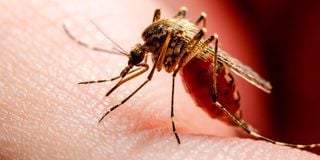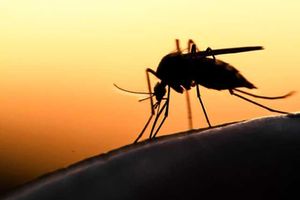Red flag over control as malaria cases, deaths rise

According to this year’s World Malaria Report released this week, Kenya has yet again recorded an increase from 3.3 million in 2020 to 3.41 million in 2021.
For decades now, mosquitoes have given scientists sleepless nights, with malaria cases on the increase every year.
According to this year’s World Malaria Report released this week, Kenya has yet again recorded an increase from 3.3 million in 2020 to 3.41 million in 2021. Related deaths also increased from 11,768 in 2020 to 12,011 in 2021.
The increase has also been recorded globally, with cases reaching 247 million in 2021, compared to 245 million in 2020 and 232 million in 2019.
The increase in the country accounted for 1.3 per cent of cases across the globe, from 1.1 per cent in 2020. With the current figures, Kenya accounted for two per cent of deaths. This decreased to 1.9 per cent in 2021.
This is a sign that there has been some laxity as far as malaria prevention, testing and treatment services are concerned, with Africa continuing to shoulder the heaviest burden. None of the countries on the continent achieved the Global Technical Strategy (GTS 2020) milestone of malaria reductions in incidence and mortality in 2021, with many remaining off track.
Although not on track to reach the GTS 2020 milestones for reductions in case incidence of 40 per cent or more, Kenya is among 15 countries on the continent to achieve a reduction in case incidence in 2021. Africa accounted for 95 per cent of all cases, equivalent to 235 million cases. Further, the region also accounted for 96 per cent of malaria deaths, constituting 593,000 deaths and nearly 80 per cent of all deaths were among under-fives.
The region alone recorded an increase in cases from 232 million in 2020 to 234 million in 2021. However, deaths decreased slightly from 599,000 in 2020 to 593,000 in 2021. Four African countries accounted for nearly half of all malaria cases globally, with Nigeria accounting for 26 per cent, the Democratic Republic of the Congo (12 per cent), Uganda (five per cent) and Mozambique at four per cent.
Malaria deaths
Four countries accounted for just over half of all malaria deaths globally, with Nigeria at 31 per cent. This means that in every 10 malaria-related deaths recorded worldwide, three were reported in Nigeria. The DR Congo had 13 per cent of the total deaths, Tanzania (four per cent) and Niger (four per cent).
Nigeria accounted for an estimated 38 per cent of global malaria deaths in under-fives.
Dr James Dan Otieno, malaria technical officer with WHO Kenya, said the country must take up ownership of the fight towards zero malaria deaths.
“We must step up innovations and expand the available complement of tools to defeat malaria. Only through bold leadership will we accelerate efforts to achieve this vision. It is morally unacceptable for Kenyan children and pregnant mothers to die from a preventable disease like malaria.”
Kenya is one of the 35 African countries that have adopted intermittent preventive treatment of malaria during pregnancy to reduce the burden. Between 2020 and 2021, the estimated coverage receiving the recommended minimum of three doses rose to over 30 per cent in Kenya, which was one of the piloting countries of the vaccine recommended by WHO in 2021 to prevent malaria in children living in regions with moderate-to-high transmission.
In 2021, about 364,000 children were reached with at least a dose of the vaccine through pilot introductions in Ghana, Kenya and Malawi, compared to 344,000 in 2020 and 189,000 in 2019.
Dr Otieno said the country will continue to work with stakeholders to invest in newer technologies to tailor interventions at the sub-national level and ensure efficiency and value for resources as the elimination agenda continues.
Prof Wolfgang Richard Mukabana, a senior research and policy analyst, has asked African countries to take part in the research and development of new technologies and innovations to reduce the burden of diseases.
He emphasised that a number of technologies have been earmarked by the African Union and agreed upon with the potential of spurring economic development on the continent.
“Africa's disease burden is unique. If Africans are not going to be proactive and start thinking about their own disease problems and coming up with solutions, then there is a high possibility that we will not make a step ahead,” he said.
Beyond treating many diseases, Prof Mukabana said gene drive can be used to change malaria-transmitting mosquitoes into organisms that cannot harbour malaria parasites.
Malaria parasites
“With the gene drive in controlling malaria, it is done in such a way that when the mosquito feeds on an infected person, malaria parasites in the person’s blood do not cause infection. So, it is just an animal that cannot cause malaria,” says Prof Mukabana, who is also the director of Emerging Health Technologies at the African Institute for Development Policy.
Work on the technology is ongoing in some laboratories on the continent, including Uganda, Burkina Faso, Mali, Ghana, Cape Verde and Tanzania transforming mosquitoes using gene drive to paralyse and make them unable to harbour parasites. In Uganda, it is about crashing the mosquito population. The gene is passed to mosquito species making them die, limiting the strategy of the mosquito population.
“Different mosquito traits mate and instead of producing offspring to come to normal numbers, it keeps crashing and with such, we may not have the species in Africa. And without a malaria-transmitting mosquito, we will not have malaria,” he said.
“Once everybody with the disease is treated, there will be no mosquito to transmit the disease unless from other continents or secondary vectors.”
Using microgrids in a mosquito control project, Prof Mukabana, the principal investigator, carried out research in 2012 on Rusinga Island in Homa Bay County, reducing mosquito population by 30 per cent. The project placed solar panels in 4,500 houses, mosquito traps were placed in the houses with the aim of mass trapping. “When the mosquitoes were trapped, they suffocated and died, this led to a 30 per cent reduction of the insects in the highland for the four years the project lasted,” he said.
After four years, the €3 million project ended, the findings were shared with the government, the paper was published and everything stopped at that, even though the grid can be used in other areas, including lighting rural health facilities. “If such a technology can be enabled, more so in malaria-endemic counties, the country will make a big difference in malaria cases,” he said.
Drones have also been used in the health sector and in malaria control and proved to be effective in spraying mosquito breeding grounds (shallow and stagnant waters), more so in places not accessible by foot.
A paper published last week titled ‘Drones for Area-Wide Larval Source Management of Malaria Mosquitoes’ conducted in Zanzibar, Tanzania, reported a 95 per cent significant drop in mosquito larvae in rice paddies.
The two-month research, led by Prof Mukabana, reported the successful use of drones to control mosquitoes. They were used for aerial application of Aquatain Mosquito Formulation, a monomolecular surface film, in an irrigated rice agro-ecosystem on Unguja Island in Zanzibar.
Nine rice paddies were randomly assigned to three treatments including the control (drone spraying with water only) with others assigned to drone spraying with AMF.
Fewer emerging adults
"Compared to control paddies, AMF treatments resulted in highly significant reductions in the number of larvae and pupae and fewer emerging adults. The residual effect of the treatment lasted for a minimum of five weeks post-treatment, with reductions in larval densities reaching 95 per cent in week five," says the research findings.
Prof Mukabana added: "Given the urgent need for outdoor malaria mosquito control measures, this approach warrants further development in terms of cost and application in rice irrigation schemes in Zanzibar and even in Kenya."
He said that the initial plan was to carry out the research in Kenya but given the ban on the use of drones, it was hectic getting a license to fly the drone.
"Coupled with the existing strategies including insecticide-treated bed nets and indoor residual spraying, the available malaria drug and vaccine, there is an urgent need for countries to start implementing some of the health technologies given the stagnation progress in the fight against malaria in Africa," Prof Mukabana said.
Kenya has over the years welcomed more research into biological control methods, especially because mosquitoes are increasingly developing resistance to some pesticides.
In July, the End Malaria Council Kenya rolled out the use of drone sprays in Busia County in an effort to combat Malaria.





